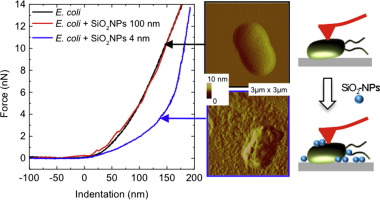Journal of Colloid and Interface Science ( IF 9.4 ) Pub Date : 2018-05-29 , DOI: 10.1016/j.jcis.2018.05.098 Marion Mathelié-Guinlet , Christine Grauby-Heywang , Axel Martin , Hugo Février , Fabien Moroté , Alexandre Vilquin , Laure Béven , Marie-Hélène Delville , Touria Cohen-Bouhacina

|
Despite great innovative and technological promises, nanoparticles (NPs) can ultimately exert an antibacterial activity by affecting the cell envelope integrity. This envelope, by conferring the cell its rigidity and protection, is intimately related to the mechanical behavior of the bacterial surface. Depending on their size, surface chemistry, shape, NPs can induce damages to the cell morphology and structure among others, and are therefore expected to alter the overall mechanical properties of bacteria. Although Atomic Force Microscopy (AFM) stands as a powerful tool to study biological systems, with high resolution and in near physiological environment, it has rarely been applied to investigate at the same time both morphological and mechanical degradations of bacteria upon NPs treatment. Consequently, this study aims at quantifying the impact of the silica NPs (SiO2-NPs) on the mechanical properties of E. coli cells after their exposure, and relating it to their toxic activity under a critical diameter. Cell elasticity was calculated by fitting the force curves with the Hertz model, and was correlated with the morphological study. SiO2-NPs of 100 nm diameter did not trigger any significant change in the Young modulus of E. coli, in agreement with the bacterial intact morphology and membrane structure. On the opposite, the 4 nm diameter SiO2-NPs did induce a significant decrease in E. coli Young modulus, mainly associated with the disorganization of lipopolysaccharides in the outer membrane and the permeation of the underlying peptidoglycan layer. The subsequent toxic behavior of these NPs is finally confirmed by the presence of membrane residues, due to cell lysis, exhibiting typical adhesion features.
中文翻译:

原子力显微镜(AFM)研究二氧化硅纳米颗粒对大肠杆菌纳米机械性能的有害影响
尽管有巨大的创新和技术前景,纳米颗粒(NPs)最终可以通过影响细胞膜的完整性来发挥抗菌活性。通过赋予细胞其刚性和保护性,该包膜与细菌表面的机械行为密切相关。根据它们的大小,表面化学性质,形状,NPs可以诱导对细胞形态和结构的破坏,因此可以预期会改变细菌的总体机械性能。尽管原子力显微镜(AFM)是研究生物系统的强大工具,具有高分辨率且在接近生理环境的环境下使用,但很少被用于同时研究NP处理后细菌的形态和机械降解。所以,2 -NPs)对大肠杆菌细胞暴露后的机械性能的影响,并将其与临界直径下的毒性作用相关联。通过将力曲线与赫兹模型拟合来计算细胞弹性,并与形态学研究相关。与细菌的完整形态和膜结构一致,直径为100 nm的SiO 2 -NPs不会引发大肠杆菌的杨氏模量的任何显着变化。相反,直径4 nm的SiO 2 -NPs确实引起了大肠杆菌的显着减少。杨氏模量,主要与外膜中脂多糖的解离和下层肽聚糖层的渗透有关。这些NP的后续毒性行为最终通过细胞裂解引起的膜残基的存在而得到证实,这些膜残基表现出典型的粘附特性。











































 京公网安备 11010802027423号
京公网安备 11010802027423号